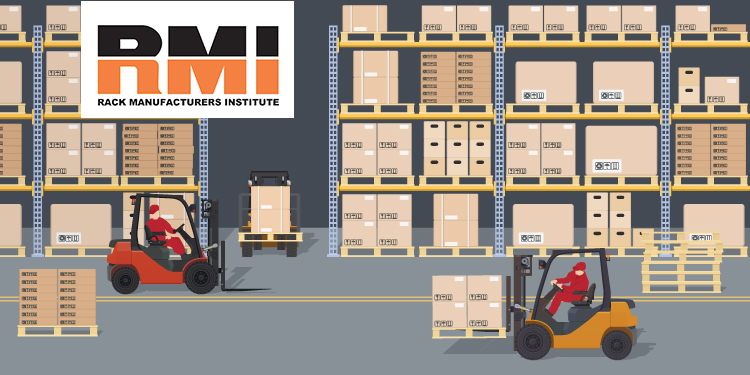Rack Safety, Design Pivotal In Growth Of MHI’s Oldest Industry Group

This article by Stephen Murdock originally appeared in the fourth quarter 2020 issue of MHI Solutions magazine and has been reprinted in its entirety with permission.
The Rack Manufacturers Institute (RMI), officially the oldest Industry Group in MHI, has seen its share of changes through the years—especially when it comes to rack safety and design. With 2020 being its 62nd anniversary, that equates to decades of knowledge compounded and built upon each year in order to ensure the safety of racks used in the material handling industry.
Carlos Oliver, president of MHI member Frazier Industrial Company and president of RMI, said the group was formed “to provide industry-wide support for testing and development of a specification for the design and use of storage rack systems.” Members support the use of the RMI code and manufacture products that are built in accordance to RMI specifications.
As the world markets continue to grow, rack systems and their designs must adapt too, which means continual re-evaluations of the products being manufactured, marketed and used. Oliver feels RMI will play a pivotal role to industry growth for years to come. “RMI will continue to test and modify the industry specifications as needed for market conditions. As concerns are raised by the industry for safety and design, the RMI will undertake new testing to address those issues. Specifically, the design of rack structures for the ever-changing seismic occurrences and the introduction of new methods of handling are constantly being considered,” he said. “The design and safety practices have changed for the better,” he assured.
He said his most memorable experience since joining RMI was when the International Building Code (IBC) adopted RMI’s specification as methodology for the design of storage racks. “I’m proud to be involved in the ongoing efforts of RMI,” he said.
Director of engineering for Frazier Industrial Company, Dan Clapp, has seen several positive changes take place since attending RMI meetings in the early 1970s. “The Uniform Building Code (UBC) had decided to include storage rack structure in the design requirements of the building code. They tried to fit rack structures into the same set of seismic design requirements as buildings but they did a poor job.” In the mid-1970s, RMI, with a grant from the National Science Foundation, sponsored theoretical calculations and full-scale storage rack seismic tests on a platform able to simulate seismic ground motions. This resulted in the first seismic design parameters and was published in the UBC Building Code. Since then there has been much research, testing (both subassembly and full-sized storage racks), and peer reviewed and published scientific papers worldwide that have been used to update and improve the RMI specification. “This specification has evolved, revised and improved over the ensuing years and continues to be used today,” said Clapp.
In the early days, the storage rack designers felt there was a disconnect between the RMI specification and what the industry was using for design of their product. “In 1999, a program, called the R-Mark was developed. This was a voluntary seal that, after an independent design process review, could be put on storage rack information, along with a professional engineer’s (PE) seal. This indicated that a licensed PE reviewed the design and certified to the end-user that the storage rack system was in compliance with the RMI specification.”
Clapp, who is also a New Jersey native, is appreciative of the opportunities afforded to him over the years. “I got involved with the technical aspects of storage rack design, participated in the RMI Engineering Committee and became the chairman in 1999. The Committee was responsible for the development of the technical aspects of storage rack design. Since the Engineering Committee was made up of delegates from each of the rack manufacturers, we spun off a Specification Advisory Committee. This team was tasked by the RMI Membership with standards development and revisions. I was also fortunate to do a lot of rack research, assisted by Teoman Pekoz, a professor at Cornell University. This work lead to several RMI specification revisions,” Clapp said.
In the coming years, the industry veteran would like to see a better understanding of storage rack behavior in the areas of higher seismic activity. “RMI is trying to sponsor instrumentation of storage rack systems so the actual system behavior can be measured, and the data used to update the seismic design requirements. The procedures are in place, but we have been unable to secure facilities that will allow this monitoring. I feel that this data will be the paradigm shift in seismic design of storage racks,” he concluded.
John Krummell, president and CEO of MHI member Advance Storage Products, is proud to see how the industry has changed and grown over the 25 plus years that he has been involved. “Back in the old days, the rack industry was a bit of the Wild West with loose standards and little enforcement. Roll forward to today and through the work of the RMI, the national building codes incorporate the rack design standards developed by RMI, ensuring that all rack systems installed meet common design and safety criteria. In addition the industry developed the R mark certification process to give rack manufacturers the ability to prove to their customer that they understand and work to the national design standards.”
Since rack systems can last for 20-plus years, several years ago RMI started a heavy focus on helping customers understand the importance of proper maintenance and repair of the rack systems throughout the lifecycle of the system. “The first step was the release of Guideline for the Assessment and Repair or Replacement of Damaged Rack – Version 1, which provided a practical guideline for the proper repair or reuse of rack systems. In our commitment to lifecycle, RMI continues to publish articles in the RMI Rack Safety blog (rmiracksafety.org) providing an easily accessible repository of knowledge. Through the years, it has been exciting to see the continued focus on providing standards, guidelines and practices to help ensure rack systems are designed and manufactured to a consistently high standard,” Krummell concluded.
Editors Note: Dan Clapp was interviewed for this article prior to his untimely death in July. MHI and the Rack Manufacturers Institute would like to express our deep sadness at Dan’s passing and to thank him for his tireless dedication, generous spirit and dedicated service to this industry.


